What is Ascaris lumbricoides?
- Ascaris lumbricoides is a significant parasitic organism classified within the genus Ascaris, specifically a type of roundworm. This species holds the distinction of being the most prevalent parasitic worm infecting humans globally. Current estimates suggest that approximately 807 million to 1.2 billion individuals are affected by A. lumbricoides, indicating a substantial public health concern. The geographic distribution of these infections is notably higher in tropical and subtropical regions, where environmental conditions facilitate the transmission of the parasite.
- The condition resulting from A. lumbricoides infection is termed ascariasis. This disease occurs when humans ingest the eggs of the roundworm, typically through contaminated food or water. Once ingested, the eggs hatch in the intestine, releasing larvae that migrate through the bloodstream to the lungs, where they mature. Subsequently, the larvae ascend the respiratory tract and are swallowed again, returning to the intestines, where they develop into adult worms. Adult A. lumbricoides can grow up to 35 centimeters in length and can reside in the human intestine for several years, producing a large number of eggs.
- Besides its impact on human health, A. lumbricoides has been proposed to share a close relationship with Ascaris suum, the roundworm commonly found in pigs. This genetic similarity has led some researchers to suggest that these two species may indeed be classified as a single species, highlighting the potential for cross-species transmission and emphasizing the importance of further study.
History and Distribution of Ascaris lumbricoides
Ascaris lumbricoides has a long and complex history, having been recognized since ancient times. Its resemblance to the earthworm led to frequent confusion, contributing to its nomenclature. The specific name “lumbricoides” derives from the Latin word Lumbricus, meaning earthworm, highlighting this physical similarity.
The following points provide a detailed exploration of the history and distribution of A. lumbricoides:
- Historical Observations:
- A. lumbricoides has been documented for centuries, indicating that awareness of this parasite dates back to ancient civilizations.
- Its initial descriptions often conflated it with the common earthworm, reflecting a limited understanding of parasitology at the time.
- Global Prevalence:
- A. lumbricoides stands as the most prevalent helminth (parasitic worm) infecting humans.
- Current estimates indicate that approximately one billion individuals worldwide are infected, making it a significant public health issue.
- High Worm Burden:
- Infected individuals may harbor a substantial number of worms, with some reports indicating burdens exceeding a thousand individuals per host.
- The staggering quantity of these parasites has raised concerns about their overall impact on human health.
- Infective Potential:
- The incidence of A. lumbricoides infections can reach alarming levels, particularly in rural areas characterized by inadequate sanitation and hygiene practices.
- Studies have shown that infection rates can range from 80% to 100% in such settings, underscoring the need for targeted public health interventions.
- Epidemiological Insights:
- An editorial published in The Lancet in 1989 noted the staggering magnitude of A. lumbricoides infections globally. If all infected roundworms were aligned end-to-end, they would theoretically encircle the Earth approximately 50 times.
- This statement emphasizes the scale of the issue and serves as a call to action for improved sanitation and education about parasitic infections.
- Current Distribution:
- A. lumbricoides is distributed worldwide, with a notable prevalence in tropical and subtropical regions.
- Environmental factors, such as climate and sanitation infrastructure, play a crucial role in the transmission dynamics of this parasite.
Habitat of Ascaris lumbricoides
- Primary Habitat:
- A. lumbricoides predominantly resides in the small intestine of its host, where it thrives in the nutrient-rich environment.
- This endoparasite is especially common among children, who may be more susceptible to infection due to their behavioral patterns and hygiene practices.
- Cosmopolitan Distribution:
- The species is cosmopolitan, meaning it can be found in various geographical locations worldwide.
- A. lumbricoides is particularly prevalent in tropical and subtropical regions, where warm, humid climates and poor sanitation conditions facilitate its transmission.
- Animal Reservoirs:
- Besides humans, A. lumbricoides has been reported in various animal hosts such as pigs, cattle, sheep, and even squirrels.
- The presence of the parasite in these animals highlights the potential for cross-species transmission and the importance of considering animal reservoirs in understanding its ecology.
- Migration Patterns:
- In some instances, A. lumbricoides exhibits migratory behavior.
- Larvae may migrate from the small intestine to the stomach, and in rare cases, they can exit the host’s body through the nostrils. This unusual migration can lead to various complications and signifies the adaptability of the parasite.
- Environmental Conditions:
- The habitat of A. lumbricoides is influenced by environmental factors such as sanitation practices, hygiene, and access to clean water.
- Poor sanitation facilitates the persistence of infective eggs in soil and water sources, enhancing the likelihood of human exposure.
- Implications for Public Health:
- The widespread habitat of A. lumbricoides and its ability to infect both humans and animals underscores its significance as a public health concern.
- Strategies aimed at improving sanitation, education on hygiene, and environmental management are vital for controlling the spread of this parasite.
Morphology of Ascaris lumbricoides
- Shape and Size:
- A. lumbricoides exhibits an elongated, cylindrical body that tapers at both ends, with the anterior end being more slender than the posterior.
- As the largest nematodes, adult females measure between 20 to 40 cm in length and 4 to 6 mm in diameter, while males are smaller, ranging from 15 to 31 cm in length and 2 to 4 mm in diameter.
- Notably, there is sexual dimorphism, meaning males and females exhibit different physical characteristics.
- Body Covering:
- The body surface is covered by a cuticle that displays minute transverse striations, giving it a pseudosegmented appearance.
- This cuticle aids in protection against the host’s immune system and facilitates the worm’s movement within the intestinal lumen.
- Coloration:
- Freshly excreted A. lumbricoides is typically yellowish-pink, transitioning to a white coloration as it ages.
- This lack of pigmentation in mature individuals is typical for many nematodes.
- Longitudinal Streaks:
- The body exhibits four longitudinal lines: one narrow mid-dorsal, one mid-ventral, and two thicker lateral lines.
- The dorsal and ventral lines appear white, while the lateral lines present a brown hue. These lines represent impressions of the syncytial epidermis.
- Anterior End:
- The anterior end features a small, terminal triradiate mouth aperture guarded by three broad lips or labia, which lack eyes.
- The structure of the lips is as follows:
- The dorsal lip is broadly elliptical.
- The two latero-ventral lips are oval-shaped, facilitating the organism’s feeding mechanism.
- Each lip is equipped with sensory papillae that enhance tactile reception, with specific configurations of denticles and papillae aiding in navigation and feeding.
- Posterior End:
- The posterior end of A. lumbricoides exhibits clear sexual dimorphism:
- In females, the posterior is conical and straight, with a mid-ventral anus guarded by one pair of postanal papillae.
- In males, the tail curves ventrally, forming a hook with a conical tip. The male anus is replaced by a cloaca, serving as a common opening for the rectum and genital tubes.
- Males possess copulatory setae or spicules, which aid in sperm transfer during mating.
- The posterior end of A. lumbricoides exhibits clear sexual dimorphism:
- Excretory Pore:
- The excretory pore is positioned mid-ventrally, near the anterior end, facilitating waste expulsion from the body.
- Female Gonopore:
- At approximately one-third of the total body length, females exhibit a vulvar waist, where the gonopore is located on the ventral surface. This structure is crucial for reproductive functions, distinguishing it from the male’s cloacal opening.
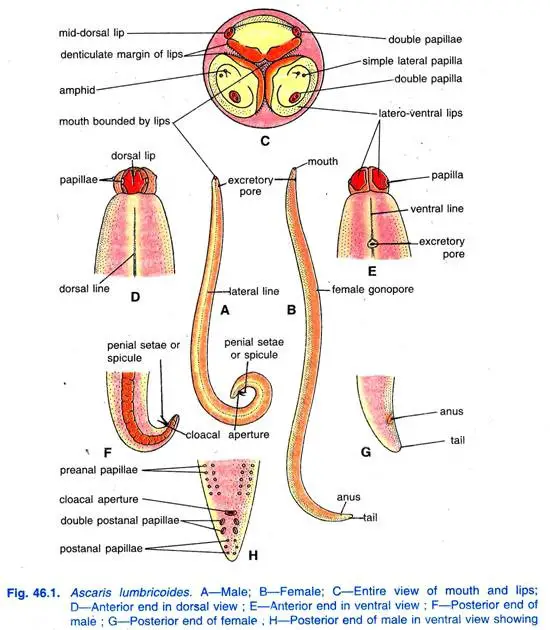
Body Wall of Ascaris Lumbricoides
The body wall of Ascaris lumbricoides is a complex structure composed of three distinct layers: the outer cuticle, the middle epidermis (also known as hypodermis), and the inner layer of longitudinal muscles. Each of these layers plays a vital role in the worm’s survival and adaptation as a parasitic organism.
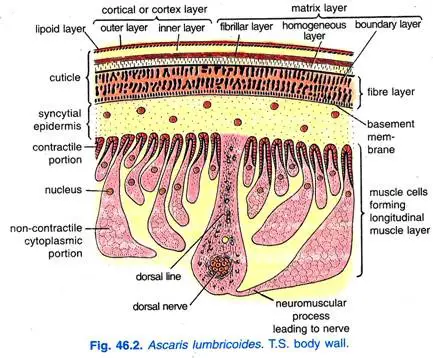
- Cuticle:
- The cuticle serves as the outermost protective layer and is thick, tough, and elastic, providing a transparent and glossy appearance.
- It is secreted by the underlying epidermis and is continuous with the cuticular lining of the pharynx and rectum.
- Notably, the cuticle is non-cellular, composed of albuminous proteins that render it resistant to the host’s digestive juices while remaining permeable to water and salts.
- As the worm matures, it sheds the cuticle to allow for growth. This shedding is a critical aspect of its life cycle.
- The cuticle is organized into several layers with numerous vertical channels and exhibits transverse wrinkles that contribute to its characteristic segmental appearance.
- Under microscopic examination, it can be identified as having four primary layers, with advanced electron microscopy revealing a fifth, lipid layer approximately 1000 Å thick. This lipid layer forms a thin osmophilic membrane.
- The cortical layer consists of keratin that provides resistance against digestive enzymes and is structured into an outer and inner layer.
- The matrix layer, which contains sulfur-rich protein matricin, provides elasticity and consists of various fibrillar structures.
- The innermost fiber layer contains collagen fibers arranged in three strata, and the basement membrane forms the inner limit of the cuticle.
- Epidermis (Hypodermis):
- The epidermis is a thin syncytial layer situated beneath the basal lamina, characterized by a high number of nuclei without distinct cell walls.
- Nuclei are located within longitudinal chords, which extend along the mid-dorsal, mid-ventral, and lateral lines, forming what are termed epidermal chords.
- The lateral chords are particularly prominent, appearing as yellow lines on the worm’s surface, and are the conduits for excretory canals and lateral nerves.
- The dorsal and ventral chords contain their respective dorsal and ventral nerves.
- This layer of the epidermis also serves as a storage site for fat and glycogen, essential for the nematode’s energy requirements.
- Unlike free-living nematodes, the epidermis of Ascaris lacks unicellular epidermal glands, highlighting its adaptation to a parasitic lifestyle.
- Longitudinal Muscle Layer:
- The inner layer comprises a single layer of longitudinal muscle cells attached to the hypodermis, with circular muscles entirely absent.
- These muscles are organized into four longitudinal columns: two dorsolateral and two ventrolateral, each containing approximately 150 muscle cells.
- The muscle cells have two distinct parts:
- A muscular part that is contractile, lying against the epidermis, and responsible for movement.
- A granular non-contractile part, shaped like a club or bladder, containing the nucleus and forming fibrous processes or muscle tails.
- Longitudinal contractile fibers are interspersed within the muscular portion, facilitating movement and providing attachment to the cuticle.
- Each muscle cell connects with the neuromuscular processes, linking the dorsolateral columns with the dorsal nerve cord and the ventrolateral columns with the ventral nerve cord.
- The muscle tails of these cells form synaptic connections with motor neurons, as emphasized by Dobell (1965), underscoring the integration of muscular and neural functions.
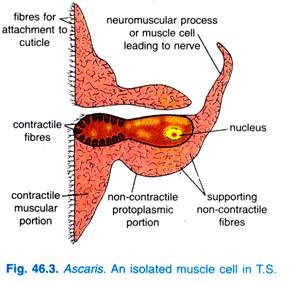
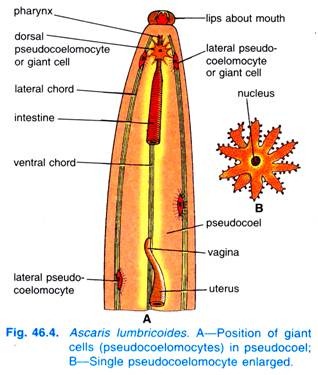
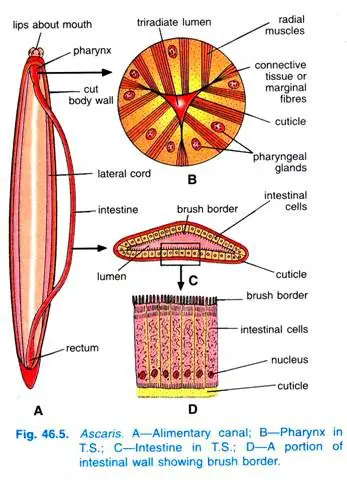
Digestive System of Ascaris Lumbricoides
The digestive system of Ascaris lumbricoides is an intricate structure that enables the nematode to efficiently extract nutrients from its host. This system is organized as a straight, complete alimentary canal that begins at the mouth and terminates at the anus. The digestive tract consists of three main components: the pharynx, the intestine, and the rectum. Each section plays a distinct role in the overall process of digestion and nutrient absorption.
- Alimentary Canal Structure:
- The alimentary canal is a straight and complete tube comprised of:
- Mouth: The starting point of the digestive process.
- Pharynx: A short, muscular structure that connects the mouth to the intestine.
- Intestine: The mid-gut where primary digestion and absorption occur.
- Rectum: The final section, leading to the anus for waste elimination.
- The alimentary canal is a straight and complete tube comprised of:
- Mouth:
- The mouth is characterized as a triradiate aperture located at the anterior tip of the worm.
- It is equipped with three labial lips that assist in food intake.
- Pharynx:
- The mouth leads into a cylindrical, thick-walled, muscular pharynx, which plays a crucial role in food processing.
- This structure features a posterior swelling known as the end bulb, equipped with valves that regulate the passage of food.
- The pharyngeal wall is composed of syncytial epithelium interspersed with radial muscle fibers, which help to dilate the lumen during feeding.
- Internally, the pharynx is lined with cuticle that continues from the body wall, and it contains three branching gland cells that secrete digestive enzymes.
- The lumen of the pharynx maintains a triradiate shape, supported by connective tissue fibers called marginal fibers.
- Intestine:
- Following the pharynx, the digestive tract continues into the intestine, which is a thin-walled, dorsoventrally flattened structure extending nearly the entire length of the body.
- The intestinal wall is lined with a single layer of tall columnar epithelial cells, supported externally by a basement membrane and a thin cuticle.
- Each epithelial cell possesses microvilli—hair-like projections that increase the surface area for absorption, formed by a bacillary layer.
- Notably, the intestine lacks muscle fibers, relying on peristalsis generated by the surrounding musculature for movement.
- Rectum:
- The rectum is the final section of the digestive system, appearing as a short, flattened tube that follows the intestine.
- Its wall is constructed from a thin layer of tall columnar epithelial cells, lined internally with cuticle and surrounded externally by muscle tissue.
- In male Ascaris, the rectum opens into a cloaca, which also receives the ejaculatory duct. In females, the rectum opens to the outside through the anus.
- The anus is flanked by specialized dilator muscles called depressor ani, which contract to facilitate the expulsion of fecal matter.
- Approximately 2 mm from the tail end, the anus or cloaca is accompanied by large unicellular rectal glands—three in females and six in males.
- Food Intake and Digestion:
- The diet of Ascaris consists primarily of blood, tissue exudates, and partially or fully digested food in a fluid state from the host’s gastrointestinal tract.
- Food intake is accomplished through the suction action of the pharynx, which draws nutrients into the digestive system.
- Digestion occurs extracellularly in the intestine, facilitated by digestive enzymes such as proteases, amylases, and lipases secreted by pharyngeal gland cells.
- The nutrients absorbed by the intestinal cells are distributed throughout the organism via the pseudocoelomic fluid.
- Excess nutrients are stored mainly as glycogen and a small amount of fat within the intestinal wall, muscle tissues, and the syncytial epidermis.
- Additionally, intercellular digestion can occur within the intestinal wall cells, which can engulf small solid particles through phagocytosis and digest them intracellularly.
- Waste Elimination:
- The elimination of undigested food, or defecation, is facilitated by the contraction of the depressor ani muscle, which elevates the dorsal wall of the rectum and the posterior lip of the anus or cloaca, thereby expelling waste materials from the body.
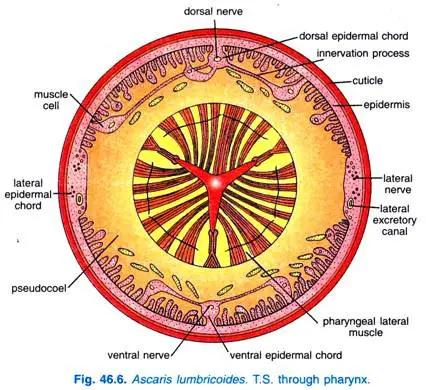
Respiration in Ascaris lumbricoides
The respiratory process in Ascaris lumbricoides, a prominent intestinal parasite, is distinctively adapted to its anaerobic environment. Lacking specialized respiratory organs, the worm relies on various mechanisms for gas exchange and energy production. This adaptation is particularly crucial as it inhabits the oxygen-poor environment of the host’s intestine.
- Absence of Respiratory Organs:
- Ascaris lumbricoides does not possess specialized respiratory structures. This characteristic is typical among many endoparasites that thrive in low-oxygen environments.
- Anaerobic Respiration:
- Given the limited availability of oxygen in the host’s gastrointestinal tract, Ascaris primarily engages in anaerobic respiration or anoxybiotic respiration.
- In this metabolic pathway, the breakdown of glycogen occurs through a process known as glycolysis, which converts glycogen into simpler molecules, yielding energy alongside by-products such as carbon dioxide and fatty acids.
- Excretion of Metabolic Waste:
- The primary metabolic wastes produced during anaerobic respiration include valerianic, butyric, and caproic acids. These fatty acids are excreted through the cuticle, a process reminiscent of waste elimination in flatworm parasites.
- Potential for Aerobic Respiration:
- While Ascaris predominantly relies on anaerobic pathways, it can also engage in aerobic respiration when free oxygen is present in the intestinal environment.
- This is supported by the presence of cytochrome, which indicates the capability for aerobic metabolic processes. Cytochrome is essential for electron transport during aerobic respiration.
- Hemoglobin and Oxygen Uptake:
- A small amount of hemoglobin is found in the body wall and pseudocoelomic fluid of Ascaris. This hemoglobin plays a critical role in oxygen uptake, allowing the parasite to utilize any available oxygen, even in minimal concentrations.
- The hemoglobin’s presence facilitates the efficient transfer of oxygen to tissues, thus supporting metabolic activities when oxygen is accessible.
Excretory System of Ascaris
The excretory system of Ascaris lumbricoides is characterized by its simplicity and efficiency, adapting effectively to the organism’s parasitic lifestyle. This nematode does not possess complex structures such as flame cells or protonephridia, but instead has a distinctive H-shaped rennet cell that plays a crucial role in its excretion processes.
Anatomy of the Excretory System
- Rennet Cells:
- The excretory system is primarily formed by a single large rennet cell, which is shaped like an “H.”
- This cell is pivotal for the functioning of the excretory system, facilitating the collection and transport of waste products.
- Longitudinal Excretory Canals:
- Two lateral longitudinal excretory canals, referred to as the right and left longitudinal excretory canals, run along the length of the body.
- The left canal is typically more developed compared to the right.
- These canals extend posteriorly and are closed at both ends.
- Transverse Canalicular Network:
- The two longitudinal canals are connected anteriorly by a transverse canalicular network situated below the pharynx.
- This network is essential for the coordination of waste transport within the excretory system.
- Structural Characteristics:
- The canals are lined by a firm membrane, covered with a layer of cytoplasm, which contributes to their structural integrity.
- The luminal surfaces of the canals do not possess cilia, suggesting a different mechanism for the movement of excretory products.
- Excretory Duct and Pore:
- From the left side of the transverse canalicular network, a short terminal excretory duct extends toward the excretory pore, located near the anterior end of the organism.
- The excretory pore serves as the exit point for waste products.
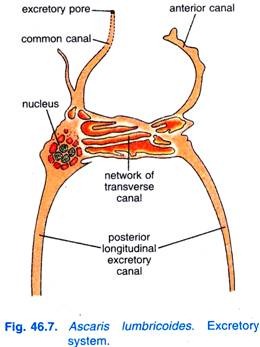
Physiology of the Excretory System
- Excretory Products:
- Ascaris lumbricoides primarily excretes urea, classifying it as a ureotelic organism.
- Urea is synthesized and subsequently diffuses into the pseudocoelomic fluid, highlighting the organism’s adaptation to its internal environment.
- Waste Collection and Elimination:
- The excretory canals play a vital role in collecting waste products from various body regions.
- These products are then directed towards the excretory pore for elimination, ensuring efficient waste removal.
- Ultrafiltration Mechanism:
- The pressure exerted by the pseudocoelomic fluid facilitates ultrafiltration within the excretory canals.
- This process enhances the efficiency of waste removal, contributing to the organism’s survival in its host environment.
- Additional Excretion:
- Besides urea, small quantities of ammonia may also be expelled through the anus, indicating a secondary excretion pathway.
Nervous System of Ascaris Lumbricoides
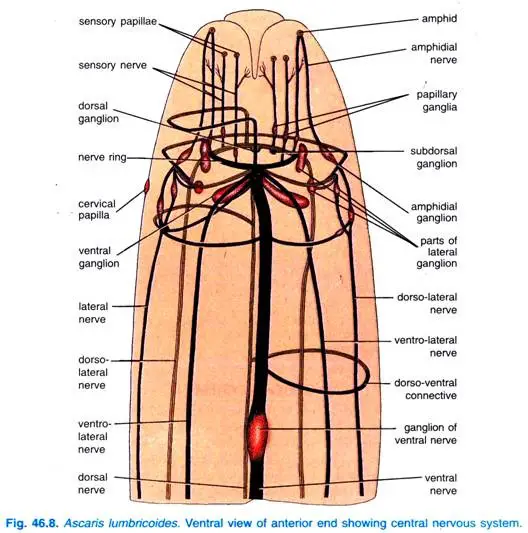
- Central Nervous System (CNS):
- The central nervous system is characterized by a ganglionated nerve ring, also known as the circumenteric ring, that encircles the pharynx.
- Components of the Nerve Ring:
- Dorsal Ganglion: An unpaired ganglion located at the dorsal side of the ring.
- Sub-dorsal Ganglia: A pair of ganglia situated close to the dorsal ganglion.
- Lateral Ganglia: A pair of lateral ganglia on either side of the ring, each divided into six smaller ganglia.
- Ventral Ganglia: A pair of large ganglia located on the ventral side of the ring.
- Each ganglion within the ring is composed of a fixed number of nerve cells, underscoring the system’s structural stability.
- Peripheral Nervous System (PNS):
- The peripheral nervous system comprises eight nerves that emanate from the nerve ring to innervate the anterior regions of the body.
- Labial Nerves: Six of these nerves supply the six labial papillae, with each nerve having a papillary ganglion near its base.
- Amphidial Nerves: The remaining two nerves are termed amphidial nerves, which innervate the amphids. Each arises from one of the six lateral ganglia, specifically known as the amphidial ganglion.
- The posterior body is supplied by six long nerves originating from the nerve ring:
- Mid-Dorsal Nerve: Located along the dorsal midline.
- Mid-Ventral Nerve: Situated along the ventral midline and is the principal nerve, exhibiting ganglionic structures along its length and referred to as the nerve cord.
- Dorsal Nerve Cord: This cord runs through the dorsal epidermal layer.
- Ventral Ganglionated Nerve Cord: This structure traverses the ventral epidermis and terminates at the posterior end, forming an anal ganglion.
- Additionally, there are four thinner nerves: a pair of dorsolateral nerves and a pair of ventrolateral nerves, located adjacent to the excretory canals.
- The peripheral nervous system comprises eight nerves that emanate from the nerve ring to innervate the anterior regions of the body.
- Transverse Commissures:
- Transverse commissures are asymmetrically arranged along the entire length of the organism, connecting the ventral nerve cord with both lateral and dorsal nerve cords, facilitating communication within the nervous system.
- Rectal Nervous System:
- In male Ascaris, the posterior end features a complex rectal nervous system that includes lateral nerve cords to supply the pre-anal papillae and a ventral nerve cord for the post-anal papillae.
- This interconnected system of dorsal, ventral, and lateral nerve cords provides a comprehensive neural network. However, this intricate rectal nervous system is notably absent in female roundworms.
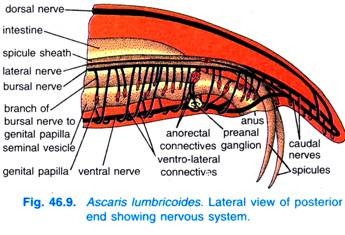
Sense Organs of Ascaris Lumbricoides
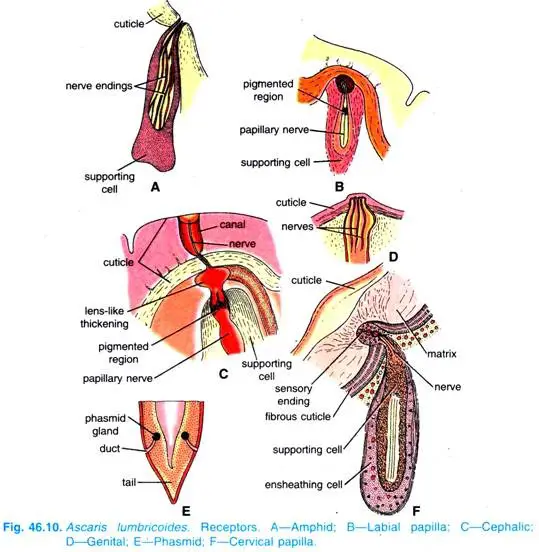
The main types of sense organs found in Ascaris include papillae, amphids, and phasmids. Below is a detailed description of these components and their functions.
- Papillae
Papillae are small, finger-like projections that are distributed across various parts of the body, serving as sensory organs.- Labial Papillae
- Description: These are located on the lips surrounding the mouth, specifically four in total: two on the dorsal lip and one each on the ventrolateral lips.
- Structure: Each labial papilla is formed by sensory cells surrounded by supporting cells.
- Function: These structures act as gustatoreceptors or taste organs, enabling the organism to sense chemical cues in its environment, which is crucial for feeding and navigation.
- Cervical Papillae
- Description: A pair of small pits located approximately 2 mm behind the lips on the dorsal side of the organism.
- Structure: Each cervical papilla consists of bulb-like nerve endings enveloped by supporting cells.
- Function: Serving as tactile organs, these papillae enhance the worm’s ability to sense touch and mechanical stimuli in its surroundings.
- Anal Papillae
- Description: Present exclusively in male Ascaris, these papillae consist of approximately 50 pairs of preanal papillae and 5 pairs of postanal papillae.
- Structure: Each anal papilla is composed of 1 to 3 nerve fibers embedded in supporting cells, situated ventrally at the posterior end.
- Function: These tactile organs are essential for copulation, facilitating the reproductive process by allowing males to detect females during mating.
- Labial Papillae
- Amphids
- Description: The amphids are small pits located on each latero-ventral lip of the organism.
- Structure: Each amphid contains glandular and nerve cells and is connected to the amphidial nerve, which arises from the lateral or amphidial ganglia.
- Function: As gustatory sensory or chemoreceptors, amphids enable Ascaris to detect chemical signals in its environment, aiding in foraging and mate selection.
- Phasmids
- Description: These are pit-like structures found behind the anus, with one located on each side of the tail.
- Structure: Phasmids are unicellular glands equipped with sensory capabilities.
- Function: As chemoreceptors, phasmids play a role in detecting environmental chemical cues, further assisting in navigation and possibly influencing mating behaviors.
Locomotion of Ascaris lumbricoides
Unlike many other organisms that rely on a variety of muscular structures for movement, Ascaris has a distinctive mode of locomotion dictated by its anatomical and physiological characteristics. Below is an overview of how this nematode achieves movement.
- Muscle Structure
Ascaris exhibits a unique muscle arrangement that facilitates its locomotion despite certain anatomical limitations.- Lack of Circular Muscles
- Description: The body wall of Ascaris is primarily composed of longitudinal muscles. Notably, it lacks circular muscles, which are commonly found in many other organisms.
- Implication: This absence restricts the organism’s ability to perform significant changes in body length during locomotion.
- Longitudinal Muscles
- Description: The body wall features four longitudinal muscle cords situated on either side of the worm.
- Function: These muscles contract to facilitate movement but do not allow for elongation in the same way circular muscles would.
- Lack of Circular Muscles
- Body Wall Characteristics
The body wall of Ascaris possesses unique properties that influence its locomotion.- Cuticle Structure
- Description: The cuticle, which is the outer layer of the body, contains fibers arranged in a spiral and mesh-like pattern.
- Function: While the fibers are inelastic, this arrangement permits limited changes in body length during movement, thus enabling some degree of flexibility.
- Cuticle Structure
- Locomotion Mechanism
Ascaris utilizes a specific mechanism to facilitate movement within its host environment.- Peristaltic Counteraction
- Description: To counteract the peristaltic movements of the host’s intestine, Ascaris has developed a unique locomotion strategy.
- Function: The dorsolateral and ventrolateral muscles at the anterior end of the worm contract alternately, producing undulating movements that allow it to navigate through the intestinal tract.
- Undulating Movements
- Description: These movements are characterized by wave-like contractions along the body.
- Function: By generating these undulations, Ascaris can effectively move in the opposite direction of peristalsis, enabling it to maintain its position and travel through the host’s intestines.
- Peristaltic Counteraction
- Advantages of Locomotion Strategy
The locomotion method of Ascaris offers several advantages in its parasitic lifestyle.- Stability in Host Environment
- Description: The ability to counteract intestinal movements allows Ascaris to remain anchored within the host, minimizing the risk of dislodgement.
- Function: This stability is crucial for its survival and reproductive success, as it allows the organism to feed and grow while avoiding expulsion.
- Energy Efficiency
- Description: The undulating movements require less energy than continuous muscle contractions across different muscle types.
- Function: This energy efficiency is particularly advantageous in the nutrient-scarce environments typically found within host intestines.
- Stability in Host Environment
Reproductive System of Ascaris Lumbricoides
The reproductive system of Ascaris lumbricoides is a complex and highly specialized structure, reflecting the organism’s dioecious nature and distinct sexual dimorphism. In this roundworm species, sexual reproduction is the sole mode of propagation, with males and females exhibiting significant differences in size and anatomical features.
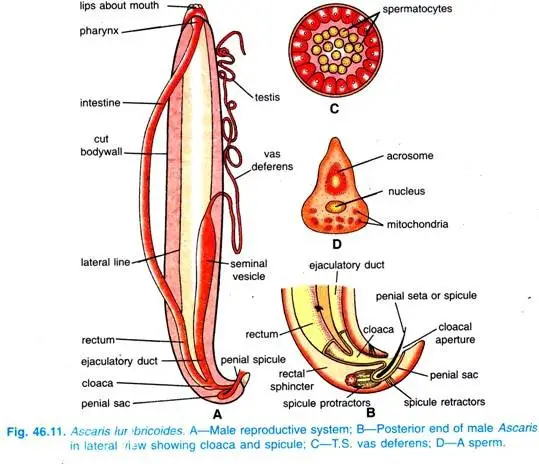
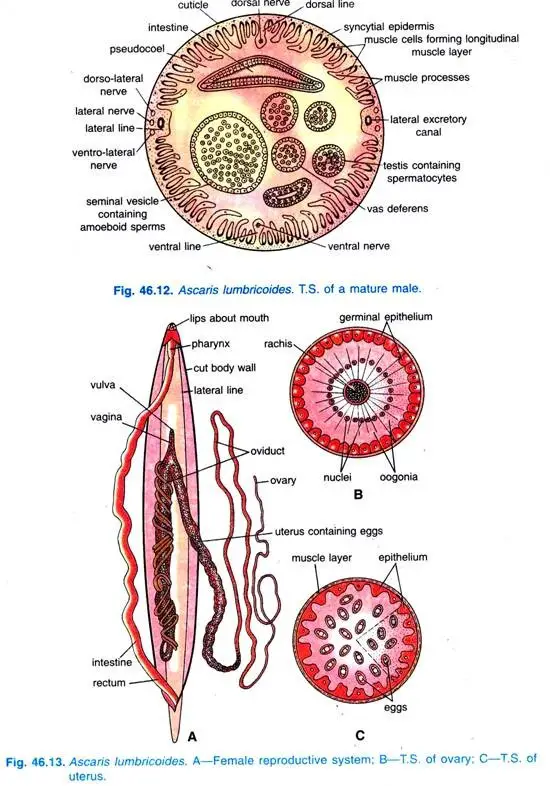
- General Characteristics
- Ascaris lumbricoides is dioecious, meaning that male and female reproductive organs are present in separate individuals.
- Males are generally smaller than females and possess a curved tail, which is equipped with pre- and post-anal papillae, a cloaca, and a pair of spicules or penial setae.
- In contrast, females have a straight tail, an anus, and lack spicules and papillae.
- The male reproductive system is simplified, consisting of a single tube, while the female reproductive system is more elaborate and comprises two tracts.
- Gonads are typically elongated, tubular, and coiled, with attachment points at the genital pore in females and at the cloaca in males.
- Male Reproductive Organs
- Testis:
- The male has a single testis, although some nematodes may possess two (diorchic).
- This structure is a long, coiled tube that connects to the vas deferens.
- The testis wall consists of a single layer of cuboidal cells, serving as a growth zone, with a central axis formed by a cytoplasmic rachis surrounded by developing sperms in various stages.
- Vas Deferens:
- The vas deferens is a short, thick, coiled tube that continues from the testis.
- It has a central lumen, distinguishing it from the testis.
- Seminal Vesicles:
- This is a longer and thicker tube where the vas deferens opens, situated in the posterior third of the pseudocoel beneath the intestine.
- Its primary function is to store mature sperm.
- Ejaculatory Duct:
- The seminal vesicle narrows at its posterior end to form a highly muscular and glandular ejaculatory duct.
- This duct opens behind the rectum via the cloacal aperture, allowing the passage of both sperm and fecal matter.
- Prostatic glands associated with the duct secrete substances that facilitate copulation.
- Penial Setae:
- Located within two spicular pouches on the dorsal side of the cloaca, these club-shaped spicules can be protruded and retracted to assist in the opening of the female gonopore during copulation.
- Each spicule is surrounded by a spicular sheath, containing a cytoplasmic core and a thick cuticle.
- Testis:
- Female Reproductive Organs
- The female reproductive organs are located in the posterior two-thirds of the pseudocoel and comprise two parallel tracts, referred to as didelphic.
- Ovaries:
- There are two elongated, thread-like ovaries that end blindly in the pseudocoel.
- Each ovary wall is made up of a single layer of cuboidal epithelial cells, supported by a basement membrane.
- The central axis is similar to that of the testis, formed by a cytoplasmic rachis surrounded by developing ova, but lacks a lumen.
- Oviducts:
- Each ovary is connected to a thick, twisted oviduct that has a lumen, marking a significant distinction from the ovaries.
- Uteri:
- Each oviduct leads to a much wider, almost untwisted uterus that serves to store fertilized eggs.
- The uterine wall is thick and composed of a layer of tufted secretory cells surrounded by a muscular layer with inner circular and outer oblique fibers.
- Vagina:
- The two uteri merge in the anterior one-third of the body to form a short, muscular vagina.
- This structure has a contractile wall and is lined internally with a cuticle, culminating in a slit-like female pore or vulva through which eggs are expelled.
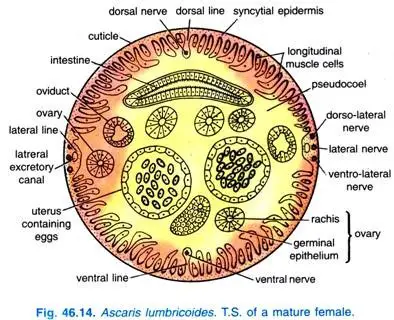
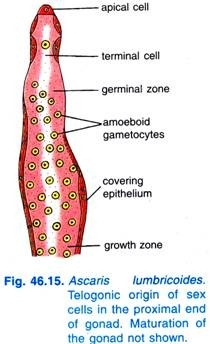
Formation of Gametes in Ascaris Lumbricoides
The formation of gametes in Ascaris lumbricoides is a complex process that involves several distinct stages of development, culminating in the production of sperm and ova. This process is characteristic of nematodes and is referred to as telogonic gametogenesis, which features a structured organization within the gonads.
- Overview of Gametogenesis
- In Ascaris, gametogonia originate from the proximal end of the gonad and migrate toward the distal end to undergo gametogenesis.
- Telogonic gametogenesis is prevalent in many nematodes and can be divided into three distinct zones: the germinal zone, growth zone, and maturation zone.
- Germinal Zone
- This zone, also referred to as the proliferation zone, is situated at the proximal blind end of the gonad.
- It typically contains a single large terminal cell, which is essential for gamete production.
- An apical cell, which is an epithelial cell located at the forefront of the terminal cell, is responsible for the budding of gametogonia.
- This initial zone is critical for initiating gametogenesis, as it provides the necessary cells for subsequent development.
- Growth Zone
- Following the germinal zone, the growth zone is where the attached gametogonia undergo significant development.
- In this region, gametogonia are linked to a structure known as the cytoplasmic rachis, which provides support and resources.
- Here, the gametogonia differentiate into amoeboid gametocytes, signifying a transition towards maturity.
- The development in this zone is crucial for the establishment of viable gametes that can undergo fertilization.
- Maturation Zone
- The maturation zone is the distal-most section of the gonad, where the gametocytes detach from the cytoplasmic rachis to undergo maturation.
- This zone is integral for the final stages of gamete formation, where gametocytes transform into mature gametes.
- The spermatozoa produced are characterized by their amoeboid shape, while the ova are elliptical.
- At this stage, the ova are classified as secondary oocytes, having developed through a single maturation division.
- Following fertilization, a second maturation division occurs, further facilitating the development of the ova.
- Final Characteristics of Gametes
- The resulting gametes from Ascaris lumbricoides exhibit distinct morphological characteristics:
- Spermatozoa: These are motile, amoeboid in structure, allowing for active movement toward the ova during fertilization.
- Ova: The mature eggs are elliptical, indicating their readiness for fertilization and subsequent development.
- The resulting gametes from Ascaris lumbricoides exhibit distinct morphological characteristics:
Life cycle of Ascaris Lumbricoides
The life cycle of Ascaris lumbricoides, the human roundworm, is a complex process that occurs solely within its primary host, humans. This monogenetic life cycle comprises several stages, each crucial for the continuation of the species. Below is a detailed examination of the various phases of Ascaris lumbricoides’ life cycle.
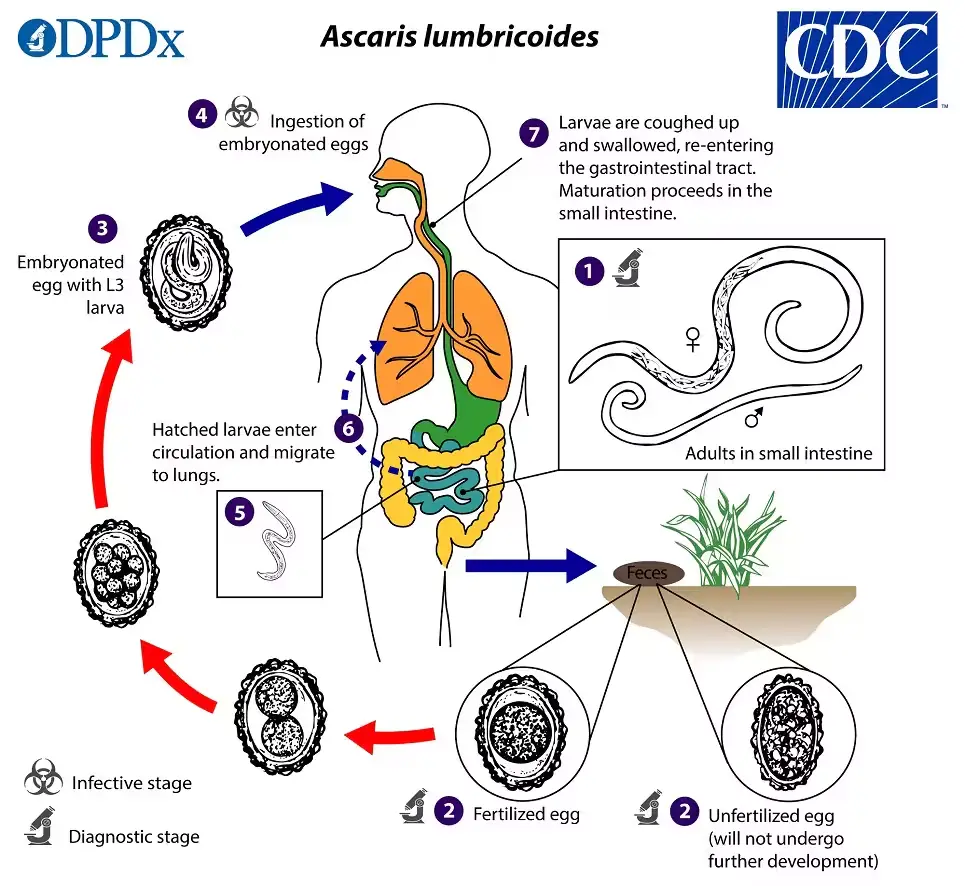
- Egg Production
- Female Reproductive Output: Mature female Ascaris can produce approximately 200,000 eggs per day.
- Fecal Shedding: These eggs are excreted in feces in an unembryonated state, rendering them non-infective initially.
- Environmental Development
- Embryonation: The eggs undergo embryonation in the soil, which requires optimal conditions of temperature (20-25ºC), moisture, and oxygen.
- Larval Development: Within a period of 3 to 6 weeks, the eggs develop into infective larvae, becoming capable of causing infection.
- Host Infection
- Ingestion of Infective Eggs: Humans acquire the infection by ingesting contaminated food or water containing the infective second-stage rhabditoid larvae within the eggs.
- Egg Hatching: Upon reaching the small intestine, digestive juices dissolve the eggshell, releasing juveniles that are approximately 0.2-0.3 mm in length and 13-15 µm in diameter. These juveniles, while resembling adults in structure, lack fully developed reproductive organs.
- Intestinal Penetration: The juveniles penetrate the intestinal wall and enter the mesenteric circulation, progressing through the hepatic portal vein to the liver.
- Migration Through the Body
- Path to the Heart: After reaching the liver, the larvae travel to the right side of the heart via the post-caval vein.
- Lung Migration: From the heart, the larvae are transported to the lungs through the pulmonary artery, where they remain for several days and increase in size.
- Development in the Lungs: In the lungs, juveniles rupture the blood capillaries, entering the alveoli. During this stage, they grow larger and undergo a series of moults, transitioning from second-stage to third-stage and then to fourth-stage larvae, with the latter growing to a length of 2 to 3 mm.
- Return to the Intestine
- Exit from the Lungs: The fourth-stage larvae exit the alveoli and travel through the bronchioles and bronchus into the trachea.
- Re-swallowing: They then reach the pharynx, where they are coughed up and subsequently swallowed for a second time into the gut.
- Final Development
- Moulting in the Intestine: Within the small intestine, the larvae undergo their final moult and reach maturity within approximately 60 to 75 days.
- Sexual Maturity: Adult Ascaris lumbricoides attain sexual maturity around 8 to 10 weeks after re-entering the intestine.
- Lifespan: The adult worms can live for 12 to 18 months within the host.
Parasitic Adaptations of Ascaris Lumbricoides
The parasitic adaptations of Ascaris lumbricoides are critical for its survival and successful reproduction within the host’s intestinal environment. These adaptations enable the organism to thrive despite the challenges posed by its parasitic lifestyle. Below is a detailed examination of these adaptations:
- Body Structure:
- Ascaris lumbricoides features an elongated, cylindrical body with pointed extremities. This shape facilitates easier movement through the intestinal tract.
- The body is covered with a robust cuticle that provides resistance to the digestive processes of the host. This protective layer is crucial for its survival, as it helps the parasite withstand harsh conditions within the host’s gut.
- Defensive Mechanisms:
- The cuticle not only offers physical protection but also secretes anti-enzymes that counteract the host’s digestive enzymes. This biochemical adaptation further enhances the parasite’s ability to evade destruction.
- Ascaris lacks specialized adhesive organs. Instead, it compensates for this deficiency with a weak locomotor ability, allowing it to maintain its position within the intestine. It counteracts intestinal peristalsis through minimal movements, which aids in its retention and feeding.
- Feeding Adaptations:
- The alimentary canal of Ascaris is relatively simple and underdeveloped. It relies on the host’s predigested and partially digested food for sustenance.
- A muscular pharynx aids in the ingestion process by creating a suction mechanism that facilitates the uptake of nutrients from the host’s gut.
- Circulatory and Respiratory Systems:
- Ascaris does not possess a circulatory system; instead, it relies on pseudocoelomic fluid to distribute nutrients and remove waste. This adaptation is effective for nutrient transport within its body.
- The organism employs anaerobic respiration, a fitting adaptation for its oxygen-poor environment in the intestine. This metabolic process enables it to thrive where oxygen levels are low.
- Sensory Adaptations:
- The sense organs of Ascaris lumbricoides are poorly developed, reflecting its sheltered existence within the host. The organism relies less on external stimuli due to its confined habitat, where survival does not require advanced sensory capabilities.
- Reproductive Strategies:
- The production of a large number of eggs compensates for potential losses during the migration from one host to another. This high reproductive rate enhances the likelihood of successful transmission to new hosts.
- The eggs possess a protective exterior that shields the developing embryos from environmental hazards. This adaptation is crucial for ensuring the survival of the eggs in various conditions.
- Egg Characteristics:
- The small size of Ascaris eggs facilitates their widespread dispersion in the environment, increasing the chances of encountering a suitable host.
- The absence of a secondary host in its life cycle promotes direct infection, enhancing the likelihood that juvenile worms will reach a new human host.
Pathogenicity of Ascaris lumbricoides
The pathogenicity of Ascaris lumbricoides, commonly known as the human roundworm, encompasses a range of detrimental effects on its host, primarily humans. Understanding these pathogenic mechanisms is crucial for appreciating the impact of this parasite on public health. Below is a detailed examination of how Ascaris lumbricoides exerts its pathogenic effects.
- Pathogenic Effects of Migrating Larvae
- Hemorrhagic Damage: Migrating larvae are more harmful than adult worms, often causing hemorrhages in the host.
- Intestinal Obstruction: These larvae can block the intestines and the appendix, leading to severe complications.
- Wandering Behavior: The larvae may migrate erratically within the host, entering the bile or pancreatic ducts.
- Interference with Digestion: Their presence in these ducts can disrupt digestive processes, potentially causing significant gastrointestinal disturbances.
- Tissue Injury: Migration through the intestinal walls can lead to injuries that result in peritonitis, a serious abdominal infection.
- Pathological Lesions: The severity of lesions caused by migrating larvae depends on several factors, including the host’s sensitivity, nutritional status, and the number of larvae present.
- Pulmonary Complications: During their migration through the lungs, larvae can induce acute pneumonia, which can be fatal. Common symptoms accompanying this include low-grade fever, cough, anemia, leukocytosis, and eosinophilia.
- Pathogenic Effects of Adult Worms
- Symptomatology: While a few adult worms may remain asymptomatic, they can still produce abdominal pain, particularly in children.
- Gastrointestinal Inflammation: Adult worms often cause enteritis and can migrate into the vermiform appendix, gall bladder, or common bile duct, leading to inflammation in these structures.
- Toxin Production: Ascaris lumbricoides produces toxins that irritate the mucous membranes of the gastrointestinal tract. This irritation can hinder protein digestion and lead to a range of systemic effects, including general nervousness, delirium, or even convulsions.
- Nutritional Impact: A substantial population of adult worms can severely impact the host’s nutritional status by competing for nutrients. They release substances that bind with trypsin, disrupting protein digestion and resulting in protein deficiency.
- Effects on Children: In children, infections are particularly concerning as they can lead to dull mental capacity, malnutrition, and stunted growth.
- Toxic Metabolites: The metabolic byproducts of live or dead worms are toxic and can trigger immune responses.
- Allergic Reactions: Ascaris lumbricoides also produces various allergic toxins that can manifest as fever, conjunctivitis, and irritation of the skin and mucous membranes.
- Mild Symptoms from Low Burden: Even a small number of parasites can cause intestinal colic, abdominal discomfort, diarrhea, vomiting, and mild fever.
Clinical manifestation of Ascaris lumbricoides
he symptomatic forms of ascariasis can generally be classified into two distinct types: intestinal ascariasis and pulmonary ascariasis.
- Intestinal Ascariasis
- Nausea: Patients often experience feelings of nausea, which can be distressing and lead to further complications.
- Vomiting: This can occur intermittently, contributing to dehydration and additional discomfort.
- Irregular Stool Patterns: Patients may experience diarrhea or irregular bowel movements, complicating the clinical picture.
- Colicky Abdominal Pain: This type of pain arises from the spasmodic contractions of the intestines as they react to the presence of the worms.
- Abdominal Distention: The accumulation of gas and the presence of the worms can lead to noticeable bloating.
- Loss of Appetite: As the body responds to the infection, a decreased desire to eat often ensues.
- Weight Loss: This is a direct consequence of malabsorption and loss of appetite.
- Intestinal Blockage: In severe cases, worms can cause obstructions, leading to excruciating pain and vomiting.
- Nutritional Malabsorption: The presence of worms interferes with the host’s ability to absorb essential nutrients.
- Growth Retardation: In children, malabsorption can significantly impact growth and development.
- Visible Worms in Stool: In cases of heavy infestation, the presence of worms may be observed in the stool.
- Complications: Severe infections can lead to complications such as appendicitis, biliary colic, perforation of the bile duct, and hepatomegaly.
- Additional Symptoms: Individuals with a heavy worm burden may also experience fatigue and fever.
- Pulmonary Ascariasis
- Transient Eosinophilic Pneumonitis (Loeffler’s Disease): This condition is characterized by the accumulation of eosinophils in the lungs, leading to elevated IgE levels.
- Bronchospasm: The presence of larvae in the lungs can trigger bronchial constriction, causing difficulty in breathing.
- Dyspnea: Patients may experience shortness of breath as the infection progresses.
- Coughing and Gagging: These symptoms arise as the body attempts to expel the larvae from the respiratory tract.
- Wheezing: Audible wheezing may be noted, indicating constriction of the airways.
- Aspiration Pneumonia: Although rare, this can occur if larvae are accidentally aspirated into the lungs.
- Hemoptysis: Blood may be present in the mucus, a sign of irritation or damage to the respiratory tissues.
- Chest Discomfort: Patients often report discomfort in the chest area, which may accompany other respiratory symptoms.
- Fever: A mild fever may occur, signaling an immune response to the infection.
Lab diagnosis of Ascaris lumbricoides
The laboratory diagnosis of Ascaris lumbricoides, a common intestinal parasite, involves a variety of techniques aimed at identifying either the adult worms or their eggs, as well as detecting specific antibodies in the host. Accurate diagnosis is crucial for effective management and treatment of ascariasis. The following outlines the methods and processes involved in diagnosing Ascaris lumbricoides infection:

- Detection of Parasite
- Adult Worm:
- The adult worms can sometimes be observed with the naked eye in the stool or sputum of patients, especially in cases of heavy infection.
- A barium meal examination may reveal the presence of an adult worm within the small intestine, aiding in the identification of the parasite.
- In patients experiencing intestinal obstruction, a plain abdominal film may display masses of worms within gas-filled loops of bowel.
- Pancreaticobiliary worms can be effectively detected using ultrasound, which has over 50% sensitivity, and endoscopic retrograde cholangiopancreatography (ERCP), which exhibits a 90% sensitivity rate.
- Larvae:
- During the early stages of infection, particularly when migrating larvae result in Loeffler’s syndrome, the larvae may be detected in sputum or, more commonly, in gastric washings.
- The presence of Charcot-Leyden crystals in the sputum, along with accompanying eosinophilia, supports the diagnosis. At this early stage, no eggs will be evident in fecal samples.
- A chest X-ray may reveal patchy pulmonary infiltrates indicative of larval migration through the lungs.
- Eggs:
- The definitive diagnosis of ascariasis is primarily achieved by demonstrating the eggs in feces. Ascaris females are prolific egg producers, with a single female capable of releasing approximately 3 eggs per milligram of feces.
- Both fertilized and unfertilized eggs are typically present in the stool; however, under certain conditions, only one type may be observed. Fertilized eggs may sometimes appear decorticated, while unfertilized eggs are not detectable by salt flotation techniques.
- In cases of light infestation, eggs may be identifiable only through concentration methods. It is also possible for eggs to be absent if only male worms are present. Therefore, careful differentiation must be made to avoid misidentifying artifacts that resemble Ascaris eggs.
- Eggs can also be detected in bile obtained via duodenal aspirates, providing another avenue for diagnosis.
- Adult Worm:
- Microscopy
- Stool samples or bile are processed as saline emulsions and examined microscopically for the presence of Ascaris eggs.
- Given the possibility of low egg count, the concentration technique may significantly enhance diagnostic yield by increasing the likelihood of egg detection under microscopic examination.
- Blood Examination
- A complete blood count (CBC) may reveal eosinophilia, particularly in the early stages of invasion. Elevated eosinophil levels are often associated with parasitic infections and may indicate the presence of Ascaris lumbricoides.
- Serological Tests
- Serological methods can detect Ascaris antibodies, contributing to the diagnosis of ascariasis. Tests include:
- Indirect hemagglutination (IHA)
- Immunofluorescence antibody (IFA)
- Enzyme-linked immunosorbent assay (ELISA)
- Serodiagnosis is particularly beneficial in cases of extraintestinal ascariasis, such as Loeffler’s syndrome, where traditional diagnostic methods may be less effective.
- Serological methods can detect Ascaris antibodies, contributing to the diagnosis of ascariasis. Tests include:
- Imaging Techniques
- In addition to the aforementioned methods, imaging techniques such as ultrasound, computed tomography (CT), and X-rays may be employed to provide further insights into the presence and extent of the infection. These methods can reveal the location of adult worms or the effects of the infection on surrounding tissues.
Treatments of Ascaris lumbricoides
The treatment of Ascaris lumbricoides infections, commonly known as ascariasis, primarily involves the administration of anti-parasitic medications. These pharmacological agents are essential in eliminating the adult worms from the host’s system. The following outlines the various treatment options available, their administration protocols, and management strategies for complications associated with ascariasis:
- First-Line Anti-Parasitic Medications
- Albendazole:
- Administered as a single dose of 400 mg orally.
- This medication acts by inhibiting the synthesis of microtubules, effectively paralyzing and killing the adult worms.
- Ivermectin:
- Dosage ranges from 150 to 200 mcg/kg, taken as a single oral dose.
- Ivermectin enhances the host’s immune response against the parasite and disrupts neuromuscular function in the worms.
- Mebendazole:
- Can be administered in two ways: either 100 mg taken orally twice daily for three days or a single dose of 500 mg.
- Similar to albendazole, mebendazole also inhibits microtubule formation, leading to the death of the adult worms.
- Pyrantel Pamoate:
- This medication is an alternative option for pregnant women, given at a dosage of 11 mg/kg (maximum 1 g) as a single oral dose.
- Pyrantel pamoate works by inducing paralysis in the worms, which are then expelled from the body through normal peristalsis.
- Albendazole:
- Management of Side Effects
- The common side effects associated with these medications include mild abdominal pain and diarrhea.
- Monitoring the patient’s response to treatment is essential to address any adverse effects promptly.
- Management of Intestinal Obstruction
- Partial Intestinal Obstruction:
- This condition should be managed conservatively with nasogastric suction to relieve the obstruction, followed by intravenous fluid administration to maintain hydration.
- Piperazine may also be instilled through the nasogastric tube to facilitate the expulsion of worms.
- Complete Intestinal Obstruction:
- Immediate surgical intervention is required in cases of complete obstruction to remove the blockage and prevent further complications.
- Partial Intestinal Obstruction:
- Contraindications and Cautions
- While many anti-parasitic drugs are effective, some are contraindicated in pregnancy. Specifically, albendazole, mebendazole, and ivermectin are generally not recommended for pregnant women due to potential risks.
- Pyrantel pamoate remains a safe alternative for pregnant patients, allowing for treatment without undue risk to the fetus.
Prophylaxis of Ascaris lumbricoides
Prophylaxis against Ascaris lumbricoides infections is essential for reducing the incidence of ascariasis, particularly in endemic regions. The primary goal of prophylactic measures is to prevent fecal contamination of soil, as this is a major transmission route for the highly resilient eggs of the parasite. The following points outline effective strategies for the prevention of ascariasis:
- Prevention of Fecal Contamination
- Elimination of fecal matter from soil is crucial, as the eggs of Ascaris can persist in the environment for extended periods due to their hardiness.
- The use of night soil (human excrement) as manure should be approached with caution. It is vital to ensure that the eggs are destroyed through proper composting techniques before application to soil.
- Vegetable Treatment
- To minimize the risk of infection, treatment of vegetables and other garden crops with iodine solution at a concentration of 200 ppm for 15 minutes is recommended.
- This process effectively kills both eggs and larvae of Ascaris and other helminths, thus reducing potential transmission through contaminated produce.
- Dietary Precautions
- Individuals should avoid consuming raw or inadequately washed vegetables, as these may be contaminated with Ascaris eggs.
- Ensuring that food is thoroughly cooked can further mitigate the risk of infection.
- Enhancement of Personal Hygiene
- Improvement in personal hygiene practices is vital. This includes regular hand washing with soap and water, especially before meals and after using the restroom.
- Education on proper sanitation practices can help reduce the risk of transmission, particularly in areas where ascariasis is endemic.
- Treatment of Infected Individuals
- Prompt identification and treatment of infected individuals, especially children, are crucial in controlling the spread of ascariasis.
- Regular health check-ups in communities can aid in early detection and treatment, thereby preventing further transmission of the parasite.
- Community Awareness and Education
- Raising awareness about the lifecycle of Ascaris lumbricoides, modes of transmission, and preventive measures is essential for effective public health strategies.
- Community education campaigns can empower individuals to take necessary precautions to protect themselves and their families.
Examples of Other Roundworms
The diverse group of roundworms, or nematodes, includes various species that can impact both animal and human health. This section presents several notable examples, detailing their life cycles, modes of transmission, and potential health implications.
- Toxocara spp.
- Species: Toxocara canis and Toxocara cati are natural parasites of dogs and cats, respectively.
- Transmission in Animals: In puppies, infection occurs via transplacental or lactogenic routes, while in kittens, lactogenic transmission is the only noted method. Adult animals typically contract the infection by ingesting infective eggs found in soil or by consuming infected paratenic hosts such as rodents and birds.
- Infective Cycle: Toxocara eggs are shed in feces, becoming infective in approximately 2-3 weeks. Humans acquire the infection through the ingestion of these eggs. Upon hatching in the small intestine, the larvae penetrate the mucosa and may migrate to the liver, lungs, or other tissues without further development.
- Clinical Manifestations: Most infections remain asymptomatic; however, in some cases, particularly in young children, visceral larva migrans may occur. Symptoms can include fever, hepatomegaly, cough, pulmonary infiltrates, eosinophilia, and hyperglobulinemia. In rare instances, ocular involvement leads to ophthalmic larva migrans.
- Baylisascaris procyonis
- Host and Transmission: This ascarid parasite primarily infects raccoons in North America and can lead to severe zoonotic infections in humans.
- Health Implications: Baylisascaris procyonis is associated with visceral larva migrans, ophthalmic larva migrans, and neural larva migrans. Complications arising from this infection may include blindness and significant central nervous system lesions, resulting in a range of symptoms from neuropsychiatric conditions to seizures, coma, and potentially fatal outcomes.
- Geohelminths
- Definition: Soil-transmitted intestinal nematodes, collectively referred to as geohelminths, require maturation of their eggs in the soil after being excreted in feces.
- Life Cycle Classification: These worms can be categorized based on their life cycles:
- Direct: Ingested infective eggs develop directly into adult forms in the intestine (e.g., whipworms).
- Modified Direct: Larvae hatch from ingested eggs, penetrate the intestinal mucosa, enter the bloodstream, and subsequently reach the gut to mature into adults (e.g., roundworms).
- Skin Penetrating: Infective larvae present in the soil penetrate the skin of the host, travel to the lungs, and then ascend to the gut, similar to the modified direct method (e.g., hookworms).
- Public Health Concerns: Geohelminths present significant health challenges, particularly in impoverished regions where sanitation and hygiene may be inadequate. Their control necessitates comprehensive measures, including education on personal hygiene, improvements in sanitation infrastructure, and access to diagnostic and treatment services.
FAQ
What is Ascaris lumbricoides?
Ascaris lumbricoides is a parasitic roundworm that lives in the small intestine of humans. It is one of the most common parasitic infections worldwide, particularly in areas with poor sanitation.
How is Ascaris lumbricoides transmitted?
Ascaris lumbricoides is transmitted through the ingestion of eggs that have been passed in the feces of infected individuals. These eggs can contaminate soil, food, or water, and can remain infectious for many years.
What are the symptoms of Ascaris lumbricoides infection?
Many people with Ascaris lumbricoides infection have no symptoms, but when symptoms occur, they can include abdominal pain, nausea, vomiting, diarrhea, and weight loss. In severe cases, the worms can cause intestinal obstruction, which can be life-threatening.
How is Ascaris lumbricoides diagnosed?
Ascaris lumbricoides infection is diagnosed by identifying the eggs in a stool sample. Sometimes, adult worms can be seen in the stool or vomit of infected individuals.
How is Ascaris lumbricoides treated?
Ascaris lumbricoides infection is usually treated with medication such as albendazole or mebendazole. In severe cases, surgery may be necessary to remove the worms.
How can Ascaris lumbricoides infection be prevented?
Ascaris lumbricoides infection can be prevented by practicing good hygiene, such as washing hands frequently with soap and water, and avoiding eating raw or undercooked vegetables that may be contaminated with soil. It is also important to treat infected individuals and properly dispose of their feces.
Who is at risk of Ascaris lumbricoides infection?
Ascaris lumbricoides infection is more common in areas with poor sanitation, particularly in developing countries. Children are also at a higher risk of infection, as they are more likely to play in contaminated soil and put their hands in their mouths.
Can Ascaris lumbricoides infection be fatal?
In most cases, Ascaris lumbricoides infection is not fatal. However, in severe cases where the worms cause intestinal obstruction, it can be life-threatening.
Can pets transmit Ascaris lumbricoides to humans?
No, Ascaris lumbricoides is a human parasite and cannot be transmitted by pets.
How long does Ascaris lumbricoides infection last?
Ascaris lumbricoides infection can last for years if left untreated. However, with proper treatment, the infection can be cleared within a few days to a few weeks.
- Paniker’s Textbook of Medical Parasitology
- Walker, M., Hall, A., & Basáñez, M.-G. (2013). Ascaris lumbricoides. Ascaris: The Neglected Parasite, 155–201. doi:10.1016/b978-0-12-396978-1.00007-0
- de Lima Corvino DF, Horrall S. Ascariasis. [Updated 2023 Jan 31]. In: StatPearls [Internet]. Treasure Island (FL): StatPearls Publishing; 2023 Jan-. Available from: https://www.ncbi.nlm.nih.gov/books/NBK430796/
- http://www.antimicrobe.org/b17.asp
- https://www.cdc.gov/dpdx/ascariasis/index.html
- https://en.wikipedia.org/wiki/Ascaris_lumbricoides
- https://www.biologyonline.com/dictionary/ascaris-lumbricoides
- https://www.cdc.gov/parasites/ascariasis/index.html
- https://www.notesonzoology.com/marine-animals/study-notes-on-ascaris-aschelminthes/1653
- https://www.biologydiscussion.com/invertebrate-zoology/phylum-aschelminthe/ascaris-lumbricoides-habitat-sense-organs-and-life-history/29004
- https://www.onlinebiologynotes.com/ascaris-lumbricoides-morphology-life-cycle-pathogenesis-lab-diagnosis-treatment/
- https://www.biologydiscussion.com/zoology/practicals/structure-of-ascaris-with-diagram-zoology-2/60355
1.life cycle of 1.trichuris ovis and 2.wuchereria bancrofti 2.Economic importance of nematodes